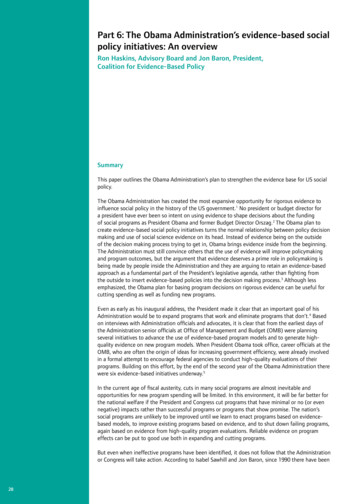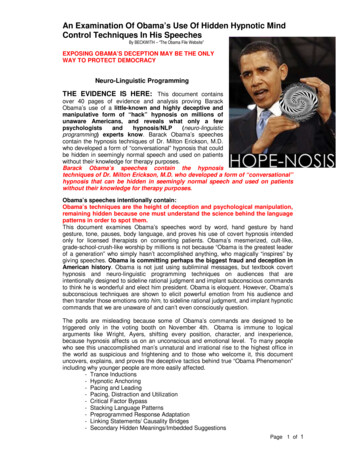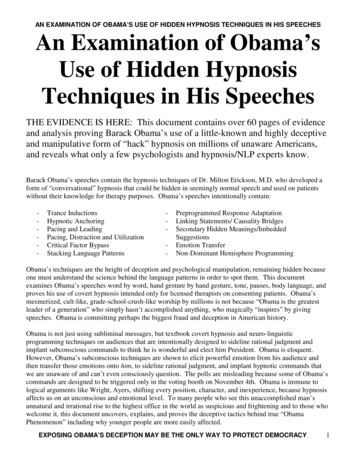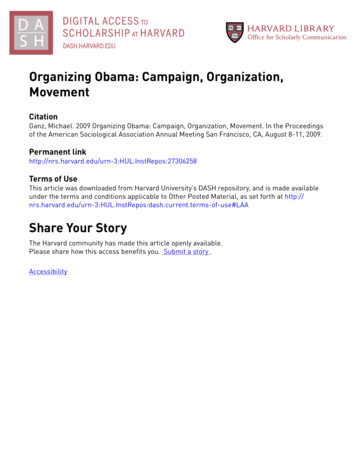
Transcription
Part 6: The Obama Administration’s evidence-based socialpolicy initiatives: An overviewRon Haskins, Advisory Board and Jon Baron, President,Coalition for Evidence-Based PolicySummaryThis paper outlines the Obama Administration’s plan to strengthen the evidence base for US socialpolicy.The Obama Administration has created the most expansive opportunity for rigorous evidence toinfluence social policy in the history of the US government.1 No president or budget director fora president have ever been so intent on using evidence to shape decisions about the fundingof social programs as President Obama and former Budget Director Orszag.2 The Obama plan tocreate evidence-based social policy initiatives turns the normal relationship between policy decisionmaking and use of social science evidence on its head. Instead of evidence being on the outsideof the decision making process trying to get in, Obama brings evidence inside from the beginning.The Administration must still convince others that the use of evidence will improve policymakingand program outcomes, but the argument that evidence deserves a prime role in policymaking isbeing made by people inside the Administration and they are arguing to retain an evidence-basedapproach as a fundamental part of the President’s legislative agenda, rather than fighting fromthe outside to insert evidence-based policies into the decision making process.3 Although lessemphasized, the Obama plan for basing program decisions on rigorous evidence can be useful forcutting spending as well as funding new programs.Even as early as his inaugural address, the President made it clear that an important goal of hisAdministration would be to expand programs that work and eliminate programs that don’t.4 Basedon interviews with Administration officials and advocates, it is clear that from the earliest days ofthe Administration senior officials at Office of Management and Budget (OMB) were planningseveral initiatives to advance the use of evidence-based program models and to generate highquality evidence on new program models. When President Obama took office, career officials at theOMB, who are often the origin of ideas for increasing government efficiency, were already involvedin a formal attempt to encourage federal agencies to conduct high-quality evaluations of theirprograms. Building on this effort, by the end of the second year of the Obama Administration therewere six evidence-based initiatives underway.5In the current age of fiscal austerity, cuts in many social programs are almost inevitable andopportunities for new program spending will be limited. In this environment, it will be far better forthe national welfare if the President and Congress cut programs that have minimal or no (or evennegative) impacts rather than successful programs or programs that show promise. The nation’ssocial programs are unlikely to be improved until we learn to enact programs based on evidencebased models, to improve existing programs based on evidence, and to shut down failing programs,again based on evidence from high-quality program evaluations. Reliable evidence on programeffects can be put to good use both in expanding and cutting programs.But even when ineffective programs have been identified, it does not follow that the Administrationor Congress will take action. According to Isabel Sawhill and Jon Baron, since 1990 there have been28
ten instances in which a large-scale federal social program was evaluated by a scientific researchdesign. In nine of these ten cases (including Job Corps, Upward Bound, 21st Century CommunityLearning Centers, and Head Start), popular programs were shown to have modest or no impactson their participants.6 So far, only the evaluation of Head Start has resulted in significant programchanges, and even here the changes are only in the initial stages of surviving the Washington policymaze and not a single Head Start program has been directly affected yet.7These examples show that the federal government needs to find a better way to spend moneyon social intervention programs. The Obama initiatives for funding social programs are the mostimportant attempts so far to find this better way and could have a major impact on how socialprograms are funded in the future by elevating the role of program evaluations in programexpansion or contraction. Moreover, if the initiatives work, the average impact of social interventionprograms on the well-being of children and families will increase and the nation will be better off.Based on several interviews with members of the Obama Administration and others inside andoutside Congress knowledgeable about the Obama initiatives, we think the following outlinecaptures key components of the President’s evidence-based initiatives (although all the initiativesdo not follow every component of the outline):1. Select an important social problem that would make individual citizens and the nation betteroff if the problem could be successfully addressed by social policy.2. Identify model programs addressed to the problem that have been shown by randomizedtrials or other rigorous research to significantly reduce the problem.3. Obtain funds from Congress to scale up evidence-based programs of this type that attackthe problem in accord with the verified models.4. Make the funds available to government or private entities with a track record of goodperformance to replicate the successful model programs and to develop new modelprograms.5. Continuously evaluate the projects as they are implemented to ensure they are faithfullyimplementing the model program and producing good results.The Obama team at the OMB came into office with strong views on the value of rigorous programevaluation. With a team of powerful OMB officials fully committed to the value of experimentalevaluations, the Obama Administration lost little time in launching its initiative to expand evidencebased social programs.8 What follows is an overview of the major characteristics and state of playfor the Administration’s six evidence-based initiatives. Table 1 provides an overview and comparisonof the major characteristics of the six initiatives. Home visiting. Home visiting is a service strategy to help families in one or more of threedomains: maternal and child health, early childhood development, and family functioning.9Several home-visiting model programs have been shown by random-assignment studies toproduce significant impacts on a variety of parenting behaviors and, less often, child outcomes.10The impacts on mothers include reduced smoking, increased employment, and improved childrearing practices. The Obama home-visiting initiative, for which Congress has approved 1.5billion over the 2010-2014 period, is awarding funds in a three-stage process. In the first stage,which has been completed, all states were eligible for a share of funding if they submittedproposals that met Administration requirements, primarily that they present a plan for conductingan assessment of the need for home visiting programs in their state. Forty-nine states, theDistrict of Columbia, and five territories were awarded funds to enter the second stage. In thesecond stage, states are required to complete their needs assessment and submit the results. Thespecific requirements for the third-stage submission have not yet been published, but it seemspossible that most or all states will receive some money and that the best applications will receivemore money. Teen pregnancy prevention. The teen pregnancy prevention initiative has proceeded in almostcomplete accord with the components of the Obama initiative outlined above. Teen pregnancy29
Table 3: The Obama plan for expanding evidence-based programs30Type ofInformationTeen PregnancyPreventioni3 (Investing inInnovation Fund)Home VisitingSocialInnovation FundTAA CommunityCollege andCareer TrainingProgramWorkforceInnovation FundAdministeringAgencyHealth andHuman ServicesEducationHealth andHuman ServicesCorporation forNational andCommunityService (CNCS)Departmentsof Labor andEducationDepartmentsof Labor andEducation(Administeredthrough the new 321 millionPartnershipfor WorkforceInnovation)Review ofLiteratureCompleted byMathematicaAlthough there was Completed byMathematicano formal reviewof literature, the i3evidence tiers werebased on a processfor reviewingevidence developedby IES over severalyears primarilythrough its workon What WorksClearinghouse andstrengthened.NoneNoNoAmount ofAwards 100 millionawarded – 75 million toreplicate existingprograms, 25million to testnew strategiesUp to 650 millionacross the threetypes of grants(development,validation, scaleup) 88 millionawarded in yearone, 1.5 billionover five years 49.2 millionawarded 500 milliona year for fouryearsNo fundedappropriated yet.2011 Budgetrequested 321million in theDepartments ofEducation andLaborReview PanelSelectionPanels includedboth expert peerreviewers andfederal staff315 peer reviewerswere selectedfrom 1,400experts in bothsubject matterand research/evaluation;reviewers assignedto panels of fivepeopleApplicationswere reviewedby grantsmanagementofficials andprogram staffA total of 60experts weredrawn from apool of experts/professionalsand the CNCSreviewer databaseof 2,300 people;reviewersassigned to panelsof 2-4 peopleNot publicyet. Technicalreview panelswill evaluateall applicationsagainstevaluationcriteria providedin applicationmaterials 108 millionSelection ofProposals75 applicantsawarded grants toreplicate existingprograms; 27grantees awardedgrants to testnew strategies49 applicationschosen as ‘highestrated.’ All securedmatching funds(20 per cent ofgrant amount)49 stategovernments, DC,and 5 territoriesapplied and wereawarded fundingfor planning;second stage offunding to follow11 granteeschosen; mustdesignatesubgranteeswithin six monthsNoUndetermined
is not only a serious national social problem with demonstrated impacts on the mother, thefather, the child, and society, it is also an area of intervention that has a long track record ofcreative and diverse programs. A comprehensive review of programs by Douglas Kirby publishedin 2001 found eight programs that had what Kirby called: “Strong evidence of success.”11 TheCoalition for Evidence-Based Policy, by contrast, has identified only one program that meetsits criteria for reaching the ‘Top Tier’ of evidence.12 There is also a comprehensive review of theevidence published by the Campbell Collaboration in 2006 that identified successful evidencebased programs.13 Thus, the first two components of our outline – selecting a serious problemand ensuring that there are evidence-based model programs – have certainly been met bythe Administration in the case of teen pregnancy prevention. Similarly, the Administrationcommissioned a literature review from Mathematica Policy Research that was made availableto the public. The review identified twenty-eight program models that were supported byhigh-quality evidence.14 Based in part on the Mathematica review, the Administration issuedits request for proposal in April 2010. The applications for funding were reviewed by a panel ofexperts based on review criteria published by the Administration. Seventy-five programs wereselected for Tier 1 funding of 75 million. In addition, 25 million was awarded to 27 Tier 2projects that have some, but not strong, evidence of success. These projects are now in variousstages of implementation. Investing in Innovation Fund (i3). The i3 Fund and the Social Innovation Fund (see below) arevery different from the home visiting and teen pregnancy reduction initiatives in that both funda more diffuse set of programs. In the case of i3, virtually any K-12 intervention with evidence ofsuccess or promise could receive funding. Another difference is that the i3 fund recognized threelevels of evidence-based programs. The top tier of funding, called scale up funds, were awardedfor programs supported by evidence from random-assignment evaluations; validation grants wereawarded to programs with some but less evidence of success; development grants were awardedto programs with a reasonable hypothesis but little or no evidence of success. In order to qualifyfor funding, the programs had to improve outcomes for pre-school children, help students qualifyfor or succeed in college, help students with disabilities or with limited-English proficiency, orserve schools in rural areas. At 650 million, i3 is the second biggest of the Obama evidencebased initiatives. Awards for 49 projects were announced in August 2010 for all three categoriesof evidence-based programs. Social Innovation Fund (SIF). The President has said that solutions to America’s challenges:“Are being developed every day at the grass roots.” and that his Administration wants to supportthose grassroots efforts.15 SIF is one method by which the Administration intends to: “Identifyand grow high-performing nonprofit organizations.” with experience at the local level.16 SIF fundsare being awarded in a two-step process. The Administration first allowed ‘intermediaries’ toaccept funds and then in turn to conduct competitions to determine which local organisationsshould receive funding. The intermediaries were organizations that had: “Strong track records ofidentifying and growing high-performing nonprofit organizations.”17 Eleven such intermediarieswere awarded 50 million in funding to go with another 74 million they had raised in matchingfunds to be distributed to nonprofit organizations. The nonprofits, which are in the process ofbeing selected now, will use the money to conduct evidence-based programs addressed to atleast one of three broad areas of social policy: economic opportunity, youth development andschool support, and promoting healthy lifestyles and avoiding risky behavior. Community College and Career Training Program. The US Department of Labor had only amodest commitment to rigorous evaluation at the beginning of the Obama Administration. Evenso, the Administration was eventually successful in getting the Department to sign off on anevidence-based initiative to provide funds for training of displaced and unemployed workers andother young adults by the nation’s community colleges. On January 20, 2011 the Department ofLabor, in conjunction with the Department of Education, announced a 2 billion initiative ( 500million a year for four years) for: “The development and improvement of postsecondary programsof two years or less that use evidence-based or innovative strategies to prepare students forsuccessful careers in growing and emerging industries.”18 An important characteristic of the grantsis that community colleges and other entities receiving the funds are to experiment with existingemployment and training materials in order to adapt them for use with young adults who seekemployment. Given the paucity of post-secondary strategies for career preparation that have astrong evidence base, it appears that this initiative will be one that focuses on developing new31
curriculums and testing them with rigorous designs. The awards will be for between 2.5 millionand 20 million and can be used to support projects using strategies that have been shownto have: “Strong or moderate evidence of positive impacts on education and/or employmentoutcomes.” Evaluation is a central feature of the Challenge Fund: 25 per cent of the assessmentof proposals is based on the evaluation plan; all evaluations must include treatment and controlgroups; and the Department of Labor will select some grantees for rigorous evaluation usingrandom assignment designs. Workforce Innovation Fund. This initiative is also being run by the Department of Laborin conjunction with the Department of Education. Five per cent of the 2011 budgets of theWorkforce Investment Act (WIA) Adult program and the WIA Dislocated Worker programwere set aside to create this fund of nearly 108 million. The fund will be used to createcompetitive grants to states or localities to replicate proven practices in training, employment,and reemployment services, especially for vulnerable groups. Like the other evidence-basedinitiatives, the fund will also be used to test promising practices. As with community collegetraining programs, there are relatively few program models for employment and training programswith young adults that have been shown by rigorous designs to produce impacts on studentlearning. It is anticipated that funds will be focused on ‘learn and earn,’ apprenticeship, andon-the-job training programs. This initiative is currently on hold because Congress did notpass any of the 2011 appropriations bills and instead enacted a ‘continuing resolution’ whichfunded programs at the 2010 level and suspended all the substantive changes (with a few minorexceptions).In addition to these six initiatives, the Administration also included money in the President’s 2011budget for program evaluation. Administration staffers estimate that there are enough funds inthe 2011 budget to pay for 23 rigorous evaluations of: “The most promising new programs” beingconducted by the various administrative departments. Indeed, the budget has well over 60 millionfor the Department of Labor alone to: “Continue to pursue a robust, Department-wide evaluationagenda.” including rigorous evaluations of WIA performance measures, effects of job counseling,use of administrative data in workforce programs, incentives for dislocated workers, and effects ofOccupational Safety and Health Administration inspections.19 In addition, the White House workedwith the Department of Labor to create a new Chief Evaluation Office that will manage the newevaluations and work with other components of the Department to assist them in conductingrigorous evaluations of their programs.These six evidence-based initiatives, plus the new funds for rigorous evaluation across the federalagencies, constitute the most sweeping and potentially groundbreaking emphasis on rigorousprogram evaluation ever pursued by the federal government.Appendix 1: Coalition for Evidence-Based Policy’s mission and activities 2009-2010Evidence-Based ReformKey to Major Gains in Education, Poverty Reduction, Crime Prevention, and Other Areas of SocialPolicyThe Coalition is a nonprofit, nonpartisan organization, whose mission is to increase governmenteffectiveness through the use of rigorous evidence about ‘what works.’ Since 2001, our workwith Congressional and Executive Branch officials has helped advance important evidence-basedreforms, described below. A recent independent assessment of our work, conducted under ourgrant agreement with the William T. Grant Foundation, found that:“The Coalition has successfully influenced legislative language, increased funding for evidencebased evaluations and programs and raised the level of debate in the policy processregarding standards of evidence. The Coalition has established a generally positive reputationas a rigorous, responsive, honest, and impartial advocate for evidence-based approaches,primarily at the federal level.”32
Problems we seek to addressFederal social programs, set up to address important US problems, often fall short by fundingmodels/strategies (‘interventions’) that are not effective.When evaluated in scientifically rigorous studies, government-funded social interventions in areassuch as K-12 education, job training, crime prevention, and poverty reduction are frequently foundto be ineffective or marginally effective. Interventions found to produce sizeable, sustained effectson important life outcomes do exist, as discussed below, but tend to be the exception. This patternoccurs in many diverse areas of social policy, as well as other fields where rigorous studies havebeen conducted (e.g. medicine and psychology).Why it mattersImproving social programs is critically needed. The United States has failed to make significantprogress in key areas such as: Poverty reduction: We have made no overall progress in reducing US poverty over the pastseveral decades. The official rate is now 13.2 per cent – slightly higher than in 1973. K-12 education: We have made very limited gains in K-12 achievement since the 1970s,according to the respected National Assessment of Educational Progress long-term trend. Economic mobility: We have seen no increase in the ability of youth to move up the economicladder relative to their parents since about 1970, according to careful studies.The opportunityRigorous studies have identified a few highly-effective social interventions.These interventions are backed by strong evidence of effectiveness – i.e., well-conductedrandomized controlled trials, carried out in typical community settings, showing sizable, sustainedeffects on important life outcomes. Although rare, their very existence suggests that a concertedeffort to grow the number of proven interventions, and spur their widespread use, couldfundamentally improve the lives of millions of Americans. Illustrative examples include: Nurse-Family Partnership – a nurse visitation program for low-income, first-time mothers (inlong-term studies, reduced child abuse and neglect by 50 per cent and, for the most at-riskchildren, produced sizable gains in educational outcomes, such as 10 per cent higher GPA). Carrera Adolescent Pregnancy Prevention Program – a youth development program for lowincome teens (at age 17, reduced girls’ pregnancies by 40-50 per cent). Career Academies – a program for at-risk students in low-income high schools (increasedaverage earnings by 2,200 per year, sustained through eight years post-graduation). Success for All in grades K-2 – a school-wide reform program, primarily for high-povertyschools (three years after program start, increased school-wide reading achievement in secondgrade by 25-30 per cent of a grade level).Such examples of proven effectiveness are rare in part because rigorous studies, such as wellconducted randomized controlled trials, are still uncommon in most areas of social policy.Meanwhile, careful investigations show that the less-rigorous studies that are typically used canproduce erroneous conclusions and lead to practices that are ineffective or harmful.Precedent from medicineRigorous studies – particularly randomized control trials – have led to remarkable improvements inhuman health over the past 50 years.Well-conducted trials have stunned the medical community by overturning widely-acceptedpractices, such as hormone replacement therapy for post-menopausal women (shown to increasethe risk of stroke and heart disease for many women), and stents to open clogged arteries (shownno better than drugs for most heart patients). Such trials have also provided the conclusive33
evidence of effectiveness for most of the major medical advances of the past half-century,including vaccines for polio, measles, and hepatitis B; effective treatments for hypertensionand high cholesterol; and cancer treatments that have dramatically improved survival rates fromleukemia, Hodgkin’s disease, breast cancer, and many other cancers.Our specific goalIncorporate two main reforms into government social programs:1. Increased funding for rigorous – including randomized – evaluations, so as to grow thenumber of research-proven interventions.2. Strong incentives and assistance for program grantees to adopt research-proveninterventions, and put them into widespread use.AccomplishmentsThe Coalition’s work with key Executive Branch and Congressional officials has helped inform and/or shape major new evidence-based policy initiatives, including: The Office of Management and Budget’s (OMB) Program Evaluation initiative ( 100 millionin the FY11 budget for rigorous evaluations to determine what works across 17 federal agencies). The Department of Health and Human Services’ (HHS) Evidence-Based Home Visitationprogram for at-risk families with young children ( 1.5 billion over five years, enacted in 2010). The Education Department’s Investing in Innovation Fund, to scale up evidence-based K-12educational strategies ( 650 million enacted in the 2009 Recovery Act). HHS’s Evidence-Based Teen Pregnancy Prevention program ( 110 million enacted for FY10). The Corporation for National and Community Service’s Social Innovation Fund, to supportpublic/private investment in evidence-based programs in low-income communities ( 50 millionenacted for FY 10).Endnotes341.Carol Weiss has recently called this “imposed” use of research. See Weiss, C.H., Murphy-Graham, E. and Birkeland, S.(2005) An Alternate Route to Policy Influence: How Evaluations affect D.A.R.E. ‘American Journal of Evaluation.’ 26.(4):12-30.2.Orszag’s take on the importance of evidence was succinctly summarized in a now-famous blog post that appearedin the midst of developing the administration’s various evidence-based initiatives. See Orszag, P. Building RigorousEvidence to Drive Policy. ‘Office of Management and Budget.’ Blog, June 8, 2009.3.It would be possible for major players in the legislative branch on either committee with jurisdiction over particularsocial programs (either the authorizing committee or the appropriations committee) to try to enact evidence-basedpolicies. Even the most powerful committee chairman, however, generally has less power and influence than thepresident. Nonetheless, powerful Congressional players could use a set of procedures, like the one we think summarizesthe Obama evidence-based initiatives, to build their own evidence-based initiative.4.Here is what President Obama said in his inaugural address: “The question we ask today is not whether our governmentis too big or too small, but whether it works – whether it helps families find jobs at a decent wage, care they can afford,a retirement that is dignified. Where the answer is yes, we intend to move forward. Where the answer is no, programswill end.”5.Funds for an initiative called the Workforce Innovation Fund, which is a mix of systems reforms of the Department ofLabor’s employment and training programs and funds for high-quality evaluations of employment and training modelprograms, was in the Obama 2011 budget. However, when Congress was unable to pass the 2011 appropriations bills,all new discretionary funding (with a few modest exceptions) was suspended. It seems doubtful that the new Congress,with a Republican controlled House will enact any new appropriations bills for 2011. The Workforce Innovation Fund isincluded in the President’s 2012 budget, but again Republican support is questionable.6.Sawhill, I.V., and Baron, J. (2010) Federal Programs for Youth: More of the Same Won’t Work. ‘Youth Today.’ May 2010,p.21.7.Guernsey, L. (2010) Proposed Rules Will Shake Up Head Start. ‘Early Ed Watch.’ Blog. New America Foundation, EarlyEducation Initiative, September 23, 2010, available at: sedrules will shake up head start-37234.
8.See: ousEvidencetoDrivePolicy9.Stoltzfus, E. and Lynch, K.E. (2009) ‘Home Visitation for Families with Young Children.’ (R40705). Washington, DC:Congressional Research Service.10. Howard, K.S. and Brooks-Gunn, J. (2009) The Role of Home-Visiting Programs in Preventing Child Abuse and Neglect.‘The Future of Children.’ 19, (2): 119-146, see especially Table 2.11. Kirby, D. (2001) ‘Emerging Answers: Research Findings on Programs to Reduce Teen Pregnancy.’ Washington, DC:National Campaign to Reduce Teen Pregnancy. p.179.12. According to the Top Tier Evidence website maintained by the Coalition, the Carrera Adolescent Pregnancy PreventionProgram is: “A comprehensive youth development program for economically disadvantaged teens, a key componentof which is reproduction health care.” The program was evaluated by a large, multi-site randomized control trial. Theevaluation’s key finding was that girls experienced a 40 to 50 per cent reduction in pregnancies and births three yearsafter random assignment. Available at: http://toptierevidence.org/wordpress/?page id 17213. Scher, L., Maynard, R.A. and Stagner, M. (2006) ‘Interventions Intended to Reduce Pregnancy-Related Outcomesamong Adolescents.’ Oslo, Norway: Campbell Coalition.14. Given the fact that the Coalition for Evidence-Based Policy, after reviewing a host of teen pregnancy preventionprograms, found only one to qualify as having ‘top tier’ evidence, it is clear that Mathematica used more flexible criteriafor determining that a program model is supported by strong evidence. Under the approach to evidence being takenby the Obama Administration, the use of more flexible criteria seems appropriate because the Administration wants todevelop new evidence in the case of models that have some but not top-tier evidence of success.15. Obama, B.H. (2010) ‘Social Innovation Fund.’ Reprinted in Office of Social Innovation and Civic Participation. Availableat: ives/social-innovation-fund16. Corporation for National and Community Service ‘Inaugural Social Innovation Fund Grants Awarded to ExperiencedInnovators.’ Press Release, July 22, 2010, available at: www.nationalservice.gov/about/newsroom/releases detail.asp?tbl pr id 182917. Corporation for National and Community Service, ‘Social Innovation Fund.’ (2010), available at: ion.asp18. Department of Labor. News Release: ‘US Labor Department Encourages Applications for Trade Adjustment AssistanceCommunity College and Career Training Grant Program.’ January 20, 2011.19. Department of Labor. ‘Budget in Brief: FY2011.’ p.3.35
The Obama Administration has created the most expansive opportunity for rigorous evidence to influence social policy in the history of the US government. 1 No president or budget director for











